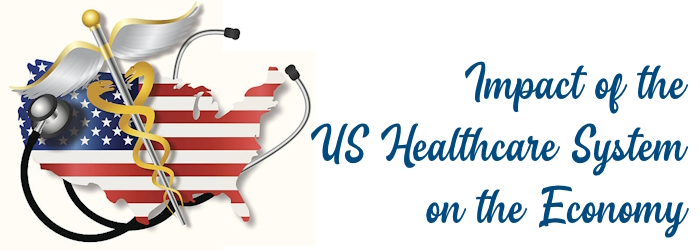How does the US Healthcare System Impact the Economy?
The United States healthcare system is known for its complexity, high costs, and extensive reach. It plays a crucial role in the country’s economy, influencing various aspects such as employment, government spending, and individual financial well-being. This article examines the multifaceted relationship between the US healthcare system and the economy, exploring its impacts, both positive and negative, backed by examples and data.

Table of Contents
- 1 Impact of the US Healthcare System on the Economy
- 1.1 Employment and Job Creation
- 1.2 Economic Output and GDP
- 1.3 Government Spending
- 1.4 Small Business Burden
- 1.5 Innovation and Research
- 1.6 Economic Disparities and Financial Burdens
- 1.7 International Competitiveness
- 1.8 Productivity and Absenteeism
- 1.9 Impact on the Insurance Industry
- 1.10 Public Health and Economic Stability
- 2 Conclusion
Impact of the US Healthcare System on the Economy
Employment and Job Creation
The US healthcare sector is a major employer, generating significant job opportunities across a wide range of occupations. According to the Bureau of Labor Statistics, healthcare employment accounted for 17.8 million jobs in 2022.
Healthcare employment is projected to grow by 16% from 2022 to 2032, much faster than the average for all occupations. This growth will create 2.3 million new jobs in the healthcare sector. This growth also contributes to economic stability and consumer spending power
Economic Output and GDP
The healthcare industry contributes significantly to the overall economic output of the United States. In 2022, healthcare spending accounted for approximately 18.4% of the country’s GDP, amounting to $4.51 trillion. This spending includes both public and private sources and encompasses various healthcare-related services, such as hospitals, pharmaceuticals, medical equipment, and insurance.
The healthcare industry is the largest private sector employer in the United States, with over 17.8 million workers. The industry is also a major driver of innovation, with new technologies and treatments being developed all the time.
Government Spending
Government spending on healthcare has a substantial impact on the economy. The US federal and state governments play a significant role in financing healthcare through programs such as Medicare, Medicaid, and the Children’s Health Insurance Program (CHIP). In 2022, government healthcare spending accounted for approximately 10.2% of the GDP, amounting to $1.4 trillion.
However, the rising healthcare costs pose a challenge for government budgets, leading to increased public debt and potential cuts in other essential sectors. Balancing the need for quality healthcare with fiscal responsibility remains a key challenge for policymakers.
Small Business Burden
The high cost of healthcare in the US poses challenges for small businesses. Small and medium-sized enterprises (SMEs) often struggle to provide affordable health insurance for their employees. This burden can hinder the growth of small businesses, as they have to divert resources that could otherwise be invested in expansion, innovation, and job creation. Consequently, the affordability and accessibility of healthcare impact entrepreneurship and overall economic dynamism.
Innovation and Research
The US healthcare system fosters innovation and research, which in turn contributes to economic growth. The country is a global leader in medical research, pharmaceutical development, and cutting-edge technologies. The presence of renowned academic institutions, research centers, and a robust private sector drives innovation and attracts investment. This leads to the creation of new therapies, medical devices, and treatment protocols, providing both health benefits and economic value.
Economic Disparities and Financial Burdens
The US healthcare system also perpetuates economic disparities and places significant financial burdens on individuals and families. High healthcare costs, including insurance premiums, copayments, and deductibles, can lead to financial hardships for many Americans. Medical debt, bankruptcy, and delayed healthcare-seeking are unfortunate consequences for those unable to afford necessary treatments.
Moreover, the link between employment and health insurance coverage creates vulnerability for individuals who lose their jobs or work in jobs that do not offer health benefits. This situation can deter individuals from pursuing entrepreneurial ventures or taking risks in the job market, impacting overall economic mobility and productivity.
International Competitiveness
The high cost of healthcare in the United States can affect the competitiveness of American businesses in the global market. Companies bear the burden of providing healthcare coverage for their employees, which increases their operating costs. This can put them at a disadvantage compared to companies in countries with lower healthcare costs, as it affects their ability to invest in research, development, and expansion. To remain globally competitive, it is essential for the US healthcare system to find ways to reduce costs while maintaining quality and access to care.
Productivity and Absenteeism
The health of the workforce is directly linked to productivity. When employees have access to quality healthcare and preventive services, they are more likely to stay healthy and be present at work. Conversely, a lack of healthcare access or untreated health conditions can lead to increased absenteeism, reduced productivity, and lower economic output. By prioritizing affordable and accessible healthcare, the US can enhance workforce productivity, leading to economic growth.
Impact on the Insurance Industry
The US healthcare system has a significant impact on the insurance industry, which plays a crucial role in the economy. Health insurance companies face challenges in balancing affordable premiums for individuals and the need to cover the high costs associated with medical treatments.
The rising healthcare costs can lead to higher insurance premiums, which can strain household budgets and limit consumer spending in other sectors. Moreover, fluctuations in healthcare policies and regulations can impact the stability of the insurance industry, influencing investor confidence and market dynamics.
Public Health and Economic Stability
Public health is intertwined with economic stability and growth. The US healthcare system’s ability to prevent, detect, and effectively respond to public health threats directly impacts the economy. For instance, the COVID-19 pandemic highlighted the interconnectedness of health and the economy.
The healthcare system’s capacity to handle a crisis, provide widespread testing and vaccination, and ensure access to care for those affected can minimize the economic impact of such events. Investing in public health infrastructure, disease surveillance, and healthcare preparedness is essential for mitigating future risks and maintaining economic resilience.
Conclusion
The US healthcare system’s impact on the economy is far-reaching and complex, with implications for employment, government spending, innovation, small businesses, international competitiveness, productivity, insurance, and public health. Addressing the challenges of cost, accessibility, and disparities within the healthcare system is crucial to fostering a healthier population, reducing financial burdens, and promoting sustained economic growth. By pursuing comprehensive reforms and prioritizing the health and well-being of its citizens, the United States can create a healthcare system that positively contributes to a prosperous and equitable economy.




